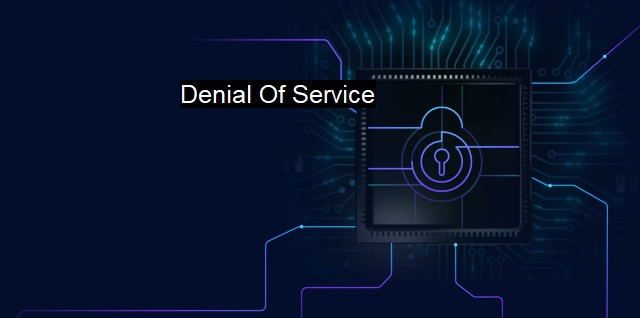What is Denial Of Service?
Understanding Denial of Service (DoS) Cyberattacks: Threats, Tactics, and Prevention Methods.
Denial of Service (DoS) represents one of the most virulent and pernicious threats encountered in the cybersecurity landscape today. Traditionally, a DoS attack is a kind of digital assault that cybercriminals implement to disrupt a server, network, or service, rendering it unavailable for legitimate users. This is generally accomplished by overwhelming these systems with an influx of unnecessary requests aimed to overload them and thereby incapacitating their normal functioning.At a more granular level, the act of performing a DoS attack involves sending more traffic to a network address than the programmers who planned its data buffers anticipated. These unprepared targets, when pushed beyond their capabilities, will overflow and subsequently crash or become effectively unresponsive to other traffic. Serving to put a spotlight on the significance of right-sizing software applications, anticipating their utilisations and predicting peak loads, a DoS attack epitomises the darker underbelly of networked, interconnected computer systems and their software underpinnings.
Such attacks are not merely limited to attacks on singular IPs, servers, or domains. The present-world Scylla and Charybdis of cybersecurity - Distributed Denial of Service (DDoS) attacks, presents an example of attacks involving a scattered net of compromised sources. Artificially amplifying traffic to unmanageable proportions, a DDoS assault cripples a server or a network by lawlessly using a group of systems and routing fake traffic via varied locations, thereby taking advantage of their often decent uptime and considerable, if not, the overwhelming bandwidth.
In terms of conceptualising a DoS or DDoS, one could tie them to a viral contagion. This subtle connection to the term "virus" conveys a lot about the threat's nature and outlines the immediate perils they pose toward unsecured systems. Much akin to biological viruses, they can quickly spread their toxic influence through a network, further suggesting the lurking connection between these cyber threats and the realm of health - a portrayal that's specifically where the term "antivirus" would trace its roots.
The developers designed antivirus software as a digital immune system for computers, shielding these systems from the perilous attacks planned by cyber predators out there. Antivirus, in this context, signifies an ally reinforcing your defense against a horde of requisitions that your system cannot handle. Following basic principles of biology, an antivirus not only focuses on neutralizing the infection but also works relentlessly to prevent future incidents, thereby augmenting cybersecurity's lasting quality.
Denial of Service attacks make a formidable opponent in the cybersecurity field, as they are somewhat easy to initiate but difficult to defend against. It requires strategic diligence, updated antivirus software, and a proactive emphasis on comprehensive up-to-date cyber defense protocols. Once a DoS attack transpires, the system must promptly initiate self-corrective measures while deploying adequate defensive actions to arrest the malicious traffic. Here, again, is where antivirus software pitches in, identifying the abnormality, defeating it, and taking steps towards preventing future similar attacks.
On the flip side, a DoS attack can also coach a system handling traffic overflow and detecting potential threats, inadvertently aiding in building a more robust digital framework. Teaching systems to self-reconstruct and adapt after an assault, cybersecurity with antivirus establishes scalable errorCode, forming one crucial lesson from the challenges that DoS attacks throw at it.
Conclusively, while Denial of Service attacks pose substantial challenges in the cybersecurity environment, they undeniably trigger a detailed comprehension of our digital landscape, improving future antivirus programs and bolstering cyber defense practices. During this era of ever-increasing connectivity, cybersecurity coupled with effective antivirus measures remains the prime lens, steadily focusing the view towards the frontier of online safety against evolving threats like DoS.+

Denial Of Service FAQs
What is a denial of service attack?
A denial of service attack (DoS) is a cyber attack that is designed to disrupt and prevent legitimate access to services or resources, such as websites, servers, or networks.How does a denial of service attack work?
A DoS attack typically involves overwhelming the target system with traffic or requests, causing it to become inaccessible or unresponsive to legitimate users. Attackers can use a variety of techniques, including flooding the target with traffic, exploiting software vulnerabilities, or conducting a distributed attack using a botnet.What can I do to protect against denial of service attacks?
There are several measures you can take to protect your systems against DoS attacks, including implementing firewalls and intrusion prevention systems, using content delivery networks and load balancers to mitigate traffic spikes, and conducting regular vulnerability assessments and penetration testing. You can also work with your internet service provider to monitor and filter traffic to your network.Can antivirus software prevent denial of service attacks?
Antivirus software is primarily designed to detect and remove malware from endpoints and networks, and may not be effective at preventing DoS attacks. However, some antivirus solutions may provide additional security features, such as intrusion detection and prevention, that can help protect against certain types of DoS attacks. It's important to use a comprehensive cybersecurity solution that includes multiple layers of protection to defend against DoS attacks and other cyber threats.| | A | | | B | | | C | | | D | | | E | | | F | | | G | | | H | | | I | | | J | | | K | | | L | | | M | |
| | N | | | O | | | P | | | Q | | | R | | | S | | | T | | | U | | | V | | | W | | | X | | | Y | | | Z | |
| | 1 | | | 2 | | | 3 | | | 4 | | | 7 | | | 8 | | |||||||